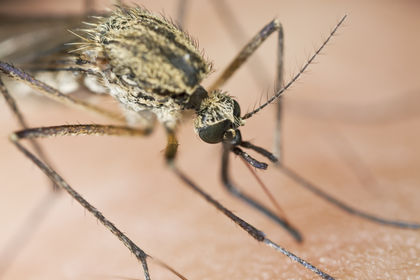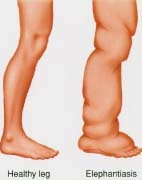Elephantiasis

Elephantiasis (el-e-fan-TY-a-sis) is the result of a tropical worm infection called filariasis (fil-a-RY-a-sis). When infected mosquitoes transmit the parasitic worm Wuchereria bancrofti to people, the worm blocks the lymphatic system. The blockage causes swelling in the legs or other parts of the body, making these body parts appear large and puffy, or elephant-like. Elephantiasis is not "elephant man disease," which is an inherited condition with completely different causes and symptoms.
KEYWORDS
for searching the Internet and other reference sources
Filariasis
Infestation
Lymphatic system
Mosquitoes
Nematodes
Parasites
Tropical diseases
Wuchereria bancrofti
Elephantiasis was known to the early Greeks and Romans. It is a tropical or subtropical disease, occurring where many kinds of disease-carrying mosquitoes are found: South America, Cuba, Puerto Rico, West Indies, Africa, Spain, Turkey, Asia, Australia, and many South Pacific Islands. About 100 million people worldwide are affected.
The Mosquito Carrier
Insects that carry diseases are known as vectors * , and several species of mosquito are vectors of Wuchereria bancrofti, the nematode worm that causes elephantiasis. When a Culex (KYU-lex), Anopheles (a-NOF-e-LEEZ), Aedes (ay-EE-deez), or Mansonia (man-SO-ne-a) mosquito carrying the Wuchereria bancrofti organism bites a human, the mosquito may inject worm larvae * into the body. The tiny larvae then may make their way into the lymph glands and the lymphatic system.
* vectors are animals or insects that carry diseases and transfer them from one host to another.
* larvae are worms at an intermediate stage of the life cycle between egg and adult.
Lymphedema
The lymphatic system is a complicated network of very fine tubes, about the diameter of a needle, which criss-cross body tissues to collect a fluid known as lymph. Lymph is a milk-like substance (containing white blood cells, proteins, and fats) that plays an important role in absorbing fats from the intestine, in fighting infections, and in the proper functioning of the immune system. Lymph is returned to the bloodstream via many vessels known as lymphatics. At various points, the lymphatics drain into masses of tissue known as lymph nodes or glands. If a blockage occurs, fluid may collect in the tissues, causing a type of swelling known as lymphedema (limf-e-DEE-ma). In the lymph system draining the legs, for example, few connections exist, and the legs often are a site of swelling when lymphedema occurs.

Lymphatic filiariasis
Worm larvae that make their way into lymph vessels can mature into adult worms. Male worms are long and slender, about 4 to 5 cm long, and 0.1 mm in diameter. Female worms are much larger, 6 to 10 cm long, and about three times wider than the males. The adults make their home mostly near the lymph glands in the lower part of the body. The adult female releases eggs enclosed within an egg membrane (microfilariae), and the microfilariae (mi-kro-fi-LAR-ee-i) develop into larvae to continue the life cycle.
In most parts of the world, microfilariae are at their peak in the blood during the night. The worms restrict the normal flow of lymph, resulting in swelling, thickening of the skin, and discoloration. This is what can cause the appearance of an elephant's leg. However, the swelling of elephantiasis usually does not occur until a person has been bitten by the disease-carrying mosquitoes many times and has had years of exposure to infected mosquitoes.
What Happens to People with Elephantiasis?
Symptoms
In addition to the characteristic swelling, people with this disorder sometimes have bouts of fever and headache. Sometimes their swollen limbs become infected.
The Elephant Man
Joseph "John" Cary Merrick was known as the Elephant Man, but he did not have elephantiasis.
Born in 1862 in Leicester, England, Merrick became a human attraction in circus side shows. His appearance was normal at birth, but when he was about age 5, he developed extensive overgrowths of skin that affected his face, head, torso, arms, and legs. He was reported to have had a 12-inch wrist and a fin-like hand.
For many years, researchers believed that Merrick had neurofibromatosis (neur-o-fib-ro-ma-TO-sis), a genetic condition that causes large growths on the skin and in tissues. Recent research using x-ray studies, however, suggests that Merrick in fact had Proteus syndrome, a condition so rare that only 100 cases in history have been reported.
Diagnosis
Microfilariae sometimes can be seen in blood under a microscope. Often the doctor diagnoses the disorder based on the symptoms and a medical history, after ruling out other disorders with similar symptoms.
Treatment
Medications are not very effective against adult worms. New microfilariae produced by the adult worms often continue to show up months after treatment.
Prevention
Because elephantiasis is found mainly in poorer countries, money for research into the cure and prevention of the disease has been limited. Effective treatment and preventive efforts would include:
- spraying to kill mosquitoes
- giving antibiotics to prevent infection
- giving medications to kill microfilariae circulating in the blood
- applying pressure bandages to reduce swelling
- surgically removing infected tissue.
See also
Bites and Stings
Parasitic Diseases
Worms
Resource
World Health Organization, Avenue Appia 20, 1211 Geneva 27, Switzerland.
WEHO posts a fact sheet about lymphatic filariasis at its website.
http://www.who.org/home/map_ht.html
Comment about this article, ask questions, or add new information about this topic: